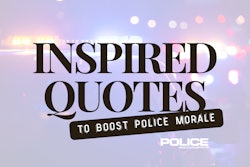"Kill me! Kill me! Kill me!" shouted 57-year-old Terry Hudson before raising the gun in his hand and pointing it at responding police officers. Those officers then opened fire, fatally striking the man.
This incident took place in Nebraska in January (as we reported here), but "suicide by cop" incidents happen all over the country and altogether too frequently.
In most of these incidents, an individual—often armed with a gun, an edged weapon, a blunt instrument, or simply concealing their hands in a way that implicates they may pose a deadly threat to the officer—is usually visibly upset, sometimes rambling incoherently or sometimes clearly articulating the fact that they want to die.
They just don’t want to kill themselves.
These situations are wildly unpredictable and extremely dangerous—responding officers need to be cautious of a possible attack on them or others in the vicinity, while also trying to use their verbal communication skills to de-escalate the situation.
Indeed, sometimes officers are able to talk a potentially suicidal subject into handcuffs and transport them to a medical facility for proper treatment of their mental or emotional distress.
For example, late last year we reported that an officer with the Fontana (CA) Police Department was able to talk a distraught man into pulling his hand from his pocket to prove that he didn't have a gun.
"Shoot me! Shoot me! Just shoot me! Please shoot me! Shoot me!" the man kept repeating as he paced back and forth in the street.
Officer Josh McMillian replied, "I do not want to shoot you."
"Please, just please. Please… please. Please shoot me," the man repeated.
McMillian said in return, "Come on. I do not want to shoot you. Pull your hand out of your pocket, bro. Come on! Don't do this man! You're going through some s#it. Let me help you!"
After a time—and the arrival of backup units—the distraught man was peacefully taken into custody.
That call ended well, but such incidents very frequently end in an officer-involved shooting—many times fatal—as an individual presents a danger to the responding officer or others nearby, necessitating the application of deadly force.
Here are some thoughts on how to prepare for the possibility of facing these difficult situations.
Visualize the Possibility
First and foremost, accept the fact that this could happen to you on any call on every shift you work. Most cops have come to this conclusion but a fair number—some who I've personally talked with—remain in some level of denial. Check that box in your head and move on.
Following that, visualize in your mind's eye how you would respond. Picture the man with the machete or the woman with the .380 pistol, pacing around and begging you to kill them. Can you create distance to mitigate the immediate threat to yourself? Have you rehearsed in your head what you might say? Have you had CIT training recently that included suicide-by-cop scenarios?
Like in professional athletics, an individual who uses mental visualizations in addition to physical practice is likely to be more successful than someone who does not use visualization as part of their preparation.
A golfer who—on the night before the final day of the four-day tournament—sits in their hotel room and visualizes what they'd do with that ugly lie in the rough 150 yards from the pin with a left-to-right crosswind has vastly increased the probability of making that shot on Sunday.
If an officer has actively played out suicide-by-cop scenarios in their mind, the brain will not consider it a new experience if it happens in the real world. Performance at the time of the incident will be enhanced and emotional reactions following the event will be less debilitating.
Finally, ask your training department if they can get access to a use-of-force simulator with suicide-by-cop scenarios programmed in—or filmed and added to the computer's library. It's not like the real thing—no UOF simulation really is—but it can be enormously helpful in preparing you for what one day might become "real world."
Know the Facts
There are some pretty clear patterns to suicide-by-cop incidents—not all of which apply at all times, of course—that you need to be aware of and be on the lookout for when you arrive to a scene with a potential suicide-by-cop subject present.
A study by the National Institutes of Health reviewed all files of officer-involved shootings investigated by the Los Angeles County Sheriff's Department from 1987 to 1997. NIH released a report on their findings in 1998.
Cases met the following criteria:
1. evidence of the individual's suicidal intent
2. evidence they specifically wanted officers to shoot them
3. evidence they possessed a lethal weapon or what appeared to be a lethal weapon
4. evidence they intentionally escalated the encounter and provoked officers to shoot them
The researchers concluded that suicide by cop accounted for 11% of all officer-involved shootings during the decade they studied.
They found that 98% of the subjects were male, and that they ranged in age from 18 to 54 years of age.
The report also revealed that 48% of weapons possessed by suicidal individuals were firearms—17% of those were replica firearms.
The median time from arrival of officers at the scene to the time of the shooting was 15 minutes with 70% of shootings occurring within 30 minutes of arrival of the responding officers.
Many of the cases of suicide by cop involved alcohol, drugs, or domestic violence—or some combination of the three.
Final Words
The abovementioned National Institutes of Health doesn't like the term "suicide by cop"—they say that the most appropriate term for this phenomenon is "law enforcement-forced-assisted suicide."
No matter what you call it, these incidents are likely to increase in coming weeks and months.
As the Coronavirus—COVID-19—outbreak continues. As people are losing their jobs and their homes and their checking accounts, the incidents of suicide by cop are likely to increase. The mental stress of "social distancing" and the economic stress of "forced lockdowns" and the sometimes permanent closures of so-called "non-essential business" may cause people to want to simply give up.
However, they may not have the means—or the will—to actually commit suicide themselves.
Thus, they will do something to cause the attention of police, who will then have to figure out what will resolve the situation.
That resolution might be handcuffs and a trip to the mental health facility or the emergency room—or it might be handgun rounds and a trip to the morgue.
Prepare yourself for either eventuality.
Be safe and be well, my friends.
















